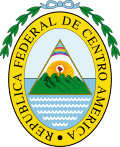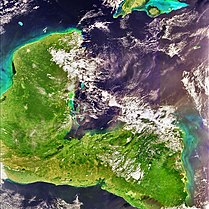
Central America is a subregion of North America. Its political boundaries are defined as bordering Mexico to the north, Colombia to the south, the Caribbean Sea to the east, and the Pacific Ocean to the west. Central America is usually defined as consisting of seven countries: Belize, Costa Rica, El Salvador, Guatemala, Honduras, Nicaragua, and Panama. Within Central America is the Mesoamerican biodiversity hotspot, which extends from northern Guatemala to central Panama. Due to the presence of several active geologic faults and the Central America Volcanic Arc, there is a high amount of seismic activity in the region, such as volcanic eruptions and earthquakes, which has resulted in death, injury, and property damage.

El Salvador, officially the Republic of El Salvador, is a country in Central America. It is bordered on the northeast by Honduras, on the northwest by Guatemala, and on the south by the Pacific Ocean. El Salvador's capital and largest city is San Salvador. The country's population in 2023 was estimated to be 6.5 million.

Central America is commonly said to include Guatemala, Belize, El Salvador, Honduras, Nicaragua, Costa Rica, and Panama. This definition matches modern political borders. Central America begins geographically in Mexico, at the Isthmus of Tehuantepec, Mexico's narrowest point, and the former country of Yucatán (1841–1848) was part of Central America. At the other end, before its independence in 1903 Panama was part of South America, as it was a Department of Colombia. At times Belize, a British colony until 1981, where English instead of Spanish is spoken, and where the population is primarily of African origin, has been considered not part of (Spanish-speaking) Central America.
The history of El Salvador begins with several distinct groups of Mesoamerican people, especially the Pipil, the Lenca and the Maya. In the early 16th century, the Spanish Empire conquered the territory, incorporating it into the Viceroyalty of New Spain ruled from Mexico City. In 1821, El Salvador achieved independence from Spain as part of the First Mexican Empire, only to further secede as part of the Federal Republic of Central America two years later. Upon the republic's independence in 1841, El Salvador became a sovereign state until forming a short-lived union with Honduras and Nicaragua called the Greater Republic of Central America, which lasted from 1895 to 1898.

The Federal Republic of Central America, originally known as the United Provinces of Central America, was a sovereign state in Central America which existed from 1823 to 1839. The federal republic was composed of five states: Costa Rica, El Salvador, Guatemala, Honduras, and Nicaragua. The federal republic was bordered to the north by Mexico, to the south by Gran Colombia, and on its eastern coastline by the Mosquito Coast and British Honduras.
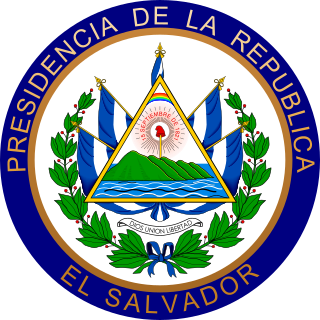
The president of El Salvador, officially titled President of the Republic of El Salvador, is the head of state and head of government of El Salvador. He is also, by constitutional law, the commander-in-chief of the Armed Forces of El Salvador. The office was created in the Constitution of 1841. From 1821 until 1841, the head of state of El Salvador was styled simply as Head of State.

Juan Nepomuceno Fernández Lindo y Zelaya was a Conservative Central American politician, provisional president of the Republic of El Salvador from 1841 to 1842 and of the Republic of Honduras from 1847 to 1852.

Rafael Antonio Gutiérrez was the president of El Salvador from 10 June 1894 to 13 November 1898. He was a leader of the Revolution of the 44 which overthrew President General Carlos Ezeta from April to June 1894. Gutiérrez served as provisional president until being officially inaugurated in March 1895 after his victory in the 1895 presidential election, in which he was the only candidate.
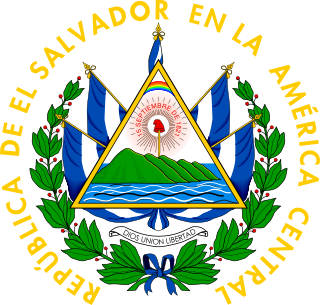
The coat of arms of El Salvador has been in use in its current form since 15 September 1912.

José Matías Delgado y de León was a Salvadoran priest and doctor known as El Padre de la Patria Salvadoreña.

Pedro Ortiz de la Barriere Castro was a Spanish politician, military officer, and lawyer who served as the colonial intendant of the Intendancy of San Salvador from 1819 until 1821. He also served the first head of state of the Province of San Salvador after the signing of the Act of Independence of Central America from September to November 1821. He was killed in action at the Battle of Milingo during the First Central American Civil War.

The 1811 Independence Movement, known in El Salvador as the First Shout of Independence, was the first of a series of revolts in Central America in modern-day El Salvador against Spanish rule and dependency on the Captaincy General of Guatemala. The independence movement was led by prominent Salvadoran and Central American figures such as José Matías Delgado, Manuel José Arce, and Santiago José Celis.

Manuel Aguilar Chacón was head of state of Costa Rica from April 1837 to March 1838.
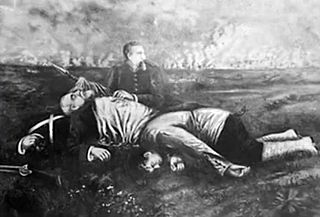
Barrios' War of Reunification, also known as Barrios' great attempt, was a war initiated by Guatemalan President Justo Rufino Barrios in 1885 with the goal of reunifying Central America. Of the five Central American countries, only Honduras supported Barrios' reunification effort; Costa Rica, El Salvador, and Nicaragua opposed it, as did Mexico.

The Intendancy of San Salvador was an administrative division of the Captaincy General of Guatemala, itself an administrative division of the Viceroyalty of New Spain which was a part of the Spanish Empire.
Antonio Basilio Gutiérrez y Ulloa was a Spanish politician and bureaucrat. He held various offices in Spain, San Salvador, New Spain, and Mexico. His most notable political office was being the Colonial Intendant of the Intendancy of San Salvador from 1805 until he was deposed in the 1811 Independence Movement. Unlike other Spanish colonial administrators, Gutiérrez y Ulloa held no military background.
Nicaraguan nationality law is regulated by the Constitution, the General Law for Migration and Foreigners, Law No. 761 and relevant treaties to which Nicaragua is a signatory. These laws determine who is, or is eligible to be, a citizen of Nicaragua. The legal means to acquire nationality and formal membership in a nation differ from the relationship of rights and obligations between a national and the nation, known as citizenship. Nicaraguan nationality is typically obtained either on the principle of jus soli, i.e. by birth in Nicaragua; or under the rules of jus sanguinis, i.e. by birth abroad to a parent with Nicaraguan nationality. It can also be granted to a permanent resident who has lived in the country for a given period of time through naturalization or for a foreigner who has provided exceptional service to the nation.
Anarchism in El Salvador reached its peak during the labour movement of the 1920s, in which anarcho-syndicalists played a leading role. The movement was subsequently suppressed by the military dictatorship before experiencing a resurgence in the 21st century.
Salvadoran nationality law is regulated by the Constitution; the Legislative Decree 2772, commonly known as the 1933 Law on Migration, and its revisions; and the 1986 Law on Foreigner Issues. These laws determine who is, or is eligible to be, a citizen of El Salvador. The legal means to acquire nationality and formal membership in a nation differ from the relationship of rights and obligations between a national and the nation, known as citizenship. Salvadoran nationality is typically obtained either on the principle of jus soli, i.e. by birth in El Salvador; or under the rules of jus sanguinis, i.e. by birth abroad to a parent with Salvadoran nationality. It can also be granted to a citizen of any Central American state, or a permanent resident who has lived in the country for a given period of time through naturalization.

From January 1822 to July 1823, the Captaincy General of Guatemala, a former Spanish colony, was controlled by the First Mexican Empire, and briefly, the Supreme Executive Power—the provisional government that succeeded Mexican imperial rule. The captaincy general consisted of the provinces of Chiapas, Costa Rica, El Salvador, Guatemala, Honduras, and Nicaragua—the six southernmost provinces of the Mexican Empire. The incorporation of Central America brought Mexico to the height of its territorial extent.
